Unlocking the Mind: The Psychology of Impactful Ads
When I was younger, I was in awe of the bold advertising campaigns depicted in movies. Simultaneously, my fascination with human behavior drew me towards anything related to psychology. I guess I always viewed these two different fields as completely separate entities that never really intertwined. However, now, as a senior majoring in both Psychology and Strategic Communication, I have come to realize how these seemingly unrelated disciplines not only coexist but also enrich one another in unexpected ways. Great advertising utilizes psychology to connect with its audience.
So let's talk about some psychology that can heavily influence how you connect with your audience, memory. When trying to connect with an audience, you obviously want them to remember it, preferably for a long time! Capturing the audience's attention is just the first step. The real challenge is ensuring your message sticks in their minds long after seeing your ad. Understanding both episodic and working memory can help elevate how advertisers engage with their target audience and enhance the likelihood of message retrieval after exposure to advertisements.
Working Memory
First, we have working memory, which is the type of memory that processes incoming information and encodes the information in the context of existing knowledge. This is where most of our conscious processing takes place. In fact, you are utilizing your working memory right now reading this. Since working memory is limited, the main goal is to make sure the message is easily digestible. This means presenting information in a way that doesn't overwhelm the audience's working memory and allows for efficient encoding and processing. Here are some ways to do it.
Simplicity and Clarity: Keep your message concise and straightforward. Working memory can become overwhelmed with too much information, so prioritize key messages and visuals to ensure they are easily processed.
Apple utilizes concise messaging and a simplistic design layout in this ad to clearly convey and connect with consumers without overloading them with too much unnecessary information.
Repetition: Reiterate essential information or key points to reinforce memory retention. This can help transfer information from working memory to long-term memory. Repetition is beneficial in overall branding, entire campaigns, and even singular ads.
Coca-Cola does a great job utilizing repetition in this specific ad visually showing the logo and slogan several times.
Imagery: Incorporate imagery, visuals, or infographics to complement your message. These can provide a visual anchor for the content, making it more memorable and easier for working memory to process.
This American Airlines ad imagery grabs an audience’s attention with the bold logo and aesthetic view. Utilizing bold imagery and minimal copy, makes this message extremely digestible and appealing.
Episodic Memory
This memory is deeply personal and represents ourselves through our past experiences, emotions, and sensations we have felt before. Episodic memory is primarily sensory, tapping into images, scents, and sounds. How can we leverage episodic memory?
Emotional Storytelling: Craft narratives that elicit strong emotions and sensory experiences. Tell stories that resonate with viewers on a personal level, triggering their episodic memory. Emotional connections enhance recall.
In this Extra Gum commercial, an emotional story unfolds as two people fall in love, with each precious moment bound together by Extra Gum. The message is powerful, evoking deep emotions that leave a lasting impression on the audience.
Nostalgia: Use elements that evoke nostalgia, as this can draw upon viewers' past memories and experiences. Nostalgia can be a powerful tool in creating a positive association with your brand.
Pepsi revived Crystal Pepsi in 2016, capitalizing on consumers' fond memories of this popular drink from the 90s and promoting the product itself with a nostalgic aesthetic.
Multi-sensory Content: Engage multiple senses in your advertising, such as incorporating music, sounds, or scents that relate to your product or service. These sensory cues can trigger episodic memory and create a stronger memory imprint.
Philadelphia Cream Cheese opened a multi-sensory dining concept called Feeladelphia that featured cheese-infused dishes inspired by feelings and designed to stimulate the senses. They also released “The Feeladelphia Experience: An Immersive Cookbook,” which included edible pages and interactive scents. This campaign pushed the boundaries of what multisensory content can look like today.
Shelby Bach is a senior Psychology and Strategic Communication double major at Texas Christian University. She currently serves as the Director of Public Relations on the Purple Team. She hopes to go to graduate school and pursue a career in Psychology. Shelby is passionate about group creativity and consumer behavior. In her free time, she loves to cook, read, and spend time with her friends.









